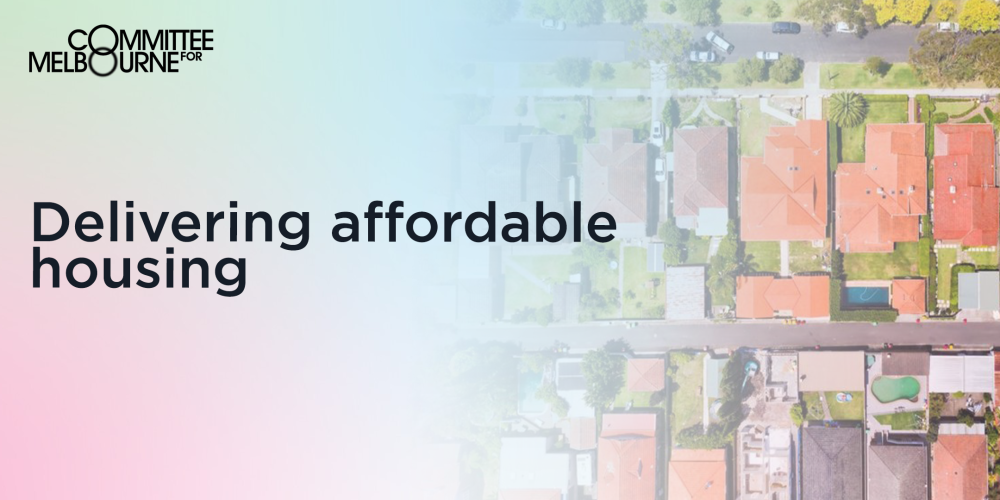Delivering Affordable Housing in Melbourne
Introduction
Melbourne faces a significant housing affordability crisis, with increasing demand for social and affordable housing driven by population growth and economic disparities. The city needs innovative strategies, strong partnerships, and comprehensive policies to address these challenges. This document highlights key barriers, explores opportunities, and outlines actions for implementing affordable housing solutions based on insights from the Transforming Housing initiative and the 2017 Housing Summit.

Establishing the Need
Melbourne’s housing needs are rapidly increasing. By 2050, the city will require 1.6 million additional homes to accommodate population growth. However, the supply of affordable housing is insufficient to meet current demands, particularly for extremely low to moderate-income households. Public housing constitutes only 2.5% of Melbourne’s housing stock, well below the national average of 4.8%. Additionally, the shortage of affordable rental properties for lower-income households is acute, with an estimated 101,000 additional social housing units needed by 2030 to meet existing and future demands.
Integrated Housing Policy
An integrated housing strategy is essential to ensure the development of affordable housing aligns with broader urban planning goals. The Victorian Government’s “Homes for Victorians” initiative and the refreshed “Plan Melbourne” provide a framework for addressing housing needs but require further refinement. Key policy components include:
- Clear Definitions and Targets: Defining affordable housing and setting measurable targets for different income levels ensures accountability and focused efforts. Metrics based on household incomes, similar to models in New South Wales and the United States, can guide affordability benchmarks.
- Spatial Housing Targets: Linking affordable housing goals to infrastructure, amenities, and employment hubs promotes sustainable development. Regional and precinct-level targets can improve planning efficiency.
- Inclusionary Zoning: Mandating a percentage of new developments for affordable housing, supported by density bonuses or fast-tracked approvals, ensures long-term affordability.
Investment and Financing Mechanisms
Delivering affordable housing at scale requires sustainable funding models and collaborative financing solutions. Recent state and federal initiatives, including the $1 billion Social Housing Growth Fund and government-backed loan guarantees, provide a foundation for progress. Key recommendations include:
- Maximizing Public and Private Funding: Leveraging philanthropic investments, private finance, and government funds ensures a diverse funding base. Competitive funding rounds encourage innovative proposals and partnerships.
- Federal Role: Reintroducing programs like the National Rental Affordability Scheme (NRAS) or implementing a bond aggregator model can attract institutional investment for affordable rental housing.
- Cross-Subsidy Models: Mixed-income developments with market-rate units subsidizing affordable housing can enhance financial feasibility and promote socioeconomic diversity.
Partnerships and Innovation
Collaboration between government, private developers, community housing providers, and philanthropic organizations is critical for scaling affordable housing initiatives. Examples of successful partnerships include:
- Public Housing Redevelopment: Projects such as the Markham Estate redevelopment demonstrate how mixed-tenure developments can increase social housing stock while fostering community cohesion.
- Utilizing Government Land: Initiatives like the VicRoads and Launch Housing partnership show how surplus government land can be repurposed for temporary and permanent affordable housing. Expanding such programs could unlock significant land resources.
- Medium-Density Developments: Encouraging secondary dwellings, laneway housing, and greyfield regeneration can increase housing diversity and supply in Melbourne’s inner and middle suburbs.
Responding to Emerging Challenges
- Disability Housing: The National Disability Insurance Scheme (NDIS) highlights the urgent need for accessible, affordable housing for people with disabilities. Specialist Disability Accommodation (SDA) funds can be utilized to create tailored housing solutions.
- Homelessness: Rising rates of rough sleeping in Melbourne’s CBD underscore the importance of last-resort housing and supportive services. Innovative approaches like modular and portable housing can provide immediate relief.
Pilot Projects and Competitions
Small-scale pilot projects and solutions competitions can test innovative housing models and build industry capacity. For example, the Melbourne Housing Expo showcases diverse housing types and tenures that address affordability and sustainability. Similarly, the Lord Mayor’s Charitable Foundation’s Affordable Housing Challenge encourages cross-sector collaborations to deliver impactful projects.
Conclusion
Melbourne’s affordable housing crisis requires a coordinated, multi-stakeholder approach that balances immediate needs with long-term sustainability. By integrating robust policies, leveraging diverse financing mechanisms, and fostering innovative partnerships, the city can create a housing ecosystem that supports all residents. The 2017 Housing Summit’s emphasis on collaboration and actionable strategies offers a blueprint for addressing these challenges and ensuring Melbourne remains a vibrant, inclusive city for future generations.
For further reading:
Homelessness and affordable housing | City of Melbourne
